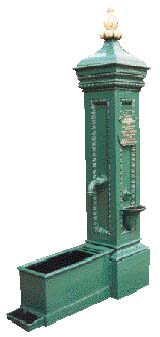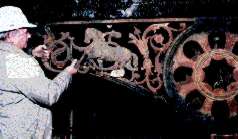Cold Metal Stitching of Historic Metalwork
Terry Sims
The repair of cast iron poses a problem. Compared with steel and wrought iron, cast iron cannot be welded easily because it is relatively brittle and can be damaged by heat. One alternative for the repair of historic originals is 'cold metal stitching'.
|
Repairing a Village Pump: The village pump in the Nottinghamshire village of Stanton-by-Dale was erected in 1897 to commemorate 'the beneficent reign of Queen Victoria'. It originally had a large horse trough and a smaller trough at ground level to satisfy the thirst of passing dogs! At some point in its history, the horse trough was filled with concrete. This absorbed rain water which froze and expanded producing numerous cracks along the base of the trough as well as breaking open one of the sides and fracturing the corner of a panel. The upper part of the decorative pump column also had large horizontal cracks which detracted from its appearance and made it structurally unsafe. In this case, repairs involved dismantling the pump to remove all of the concrete, then employing a combination of metal stitching and 'insert' techniques to repair fractures and replace sections of missing material. In addition, the pump column was made structurally safe with new internal steelwork. During the rebuilding phase, the pump handle and spout were refitted and the decorative sections restored to their former appearance. Now resplendent in its finished coat of green and gold paint, the pump will continue to delight residents and visitors to Stanton-by-Dale. |
As an iron alloy with a high carbon content, cast iron is an ancient material which was valued for its great strength in compression. With major improvements in furnace technology in the mid 18th century, the cost of manufacture fell, and production began on a mass scale.
Being strong in compression, the material was well suited for the casting of columns supporting heavy industrial floor loads in the burgeoning factories and warehouses of the early industrial revolution. Being cast, it was also ideally suited to the mass production of repetitive details: columns, for example, could be embellished with the classical orders at little extra cost. The growth of the railways saw it used for the sumptuous decoration of platform roofs, and allowed the distribution of heavy cast iron goods for every conceivable use nation-wide. The manufacturers exploited its potential to the full.
Many of Britain's finest buildings originate from the Victorian era when cast iron production was at its height, both for structural and decorative building purposes. This legacy of craftsmanship can be seen today in a rich variety of outdoor structures from ornate Victorian bandstands to village pumps.
However, cast ironwork is inherently brittle, so it is not unusual for some damage to have occurred with the passing of time. In the interior of buildings, sections of banisters are often found to be broken or cracked as a result of 'mechanical' accidental damage. In the case of outdoor structures, ironwork is also exposed to the elements and the risk of cracking through frost damage.
THE ALTERNATIVES
Repairing cast ironwork is not quite as straight forward as many people imagine. In order to weld or braze cast iron, special heat treatment procedures are required, and even then there is some risk of damage, due to thermal stresses created in the material which might cause it to distort, embrittle, or even shatter, and the material may recrystalise if too much heat is applied. Successful welding usually involves dismantling the ironwork, taking it to a workshop and preheating it before welding to ensure a gradual temperature change. It must then be reassembled on site, all of which can be time consuming and expensive.
Where historic ironwork is concerned, repair methods should always be chosen to minimise risk, and to retain as much of the original as possible. Cold metal stitching overcomes much of the disruption caused by welding and is far more economical. However, this too is a specialist process which is carried out by only a handful of British companies.
The main advantage of this method of repair is that it can usually be carried out insitu so there is minimal disturbance to the fabric of the building. This also ensures that as much as possible of the original character of the ironwork is preserved.
THE COLD METAL STITCHING TECHNIQUE
|
|
Cold metal stitching has been used for repairing equipment and machinery in the engineering industry for more than 100 years, but it is only during the last few decades that it has been more widely applied to the repair of architectural castings.
The process begins by drilling a line of holes at right angles to the crack in the casting and then converting them into a slot. To achieve the correct spacing for the holes a special drilling jig is used with centres at 1/8", 5/32", 3/16" or 1/4" depending on the thickness of the material which is being repaired.
Pre-formed locks are then fitted into the slots to create a bridge across the broken sections. The locks are made from a high nickel steel with the same co-efficient of expansion as the cast iron. This material is specifically chosen because it is strong enough to take shear loads, but sufficiently ductile to provide the necessary elasticity.
Most repairs will have a series of locks and stitches spaced at regular intervals along the crack. When this is completed, holes are drilled along the line of the fracture between each stitch. These are tapped to receive special screws which fill the crack and ensure that it is completely watertight.
Finally, the area which has been stitched is ground level to the surface of the original material to create a seamless repair. In this way, when the crack has been repaired the area of metal is often stronger than the original cast iron material, and when it has been primed and painted the repair can be invisible.
In some cases involving heavy loading stresses, such as the repair of cast iron columns, there is a need to provide extra reinforcement. In these circumstances, a 'master key' is inserted in addition to the normal 'stitches'. The 'master key' is a larger section of metal which can be varied in shape or size to suit the particular requirements of the repair, but basically it involves a larger bridging section which is fitted using the same technique as conventional stitching.
In cases where whole sections of material are missing due to the effects of corrosion or mechanical damage, a patch of metal, known as an 'insert', can be made to fill the gap and stitched into position. Inserts of this type can be anything from a few inches wide to several feet.
APPLICATIONS
In all its variety, Victorian cast ironwork is a fascinating and extremely worthy part of our architectural heritage. Because of its strength, cold metal stitching enables original structural elements to remain functional, carrying the same loads and operating in the same manner as originally intended (provided that the original design was not, in itself, inadequate for the purpose). Decorative and historic designs can be preserved in their authentic richness and detail, usually at a cost far less than replacing them with something more modern, but perhaps lacking in the same amount of character.
The process can be applied to a multitude of applications ranging from the replacement of finials and sections of railings to the repair of major structural elements such as columns and spandrel brackets.





